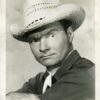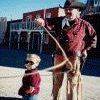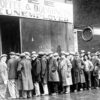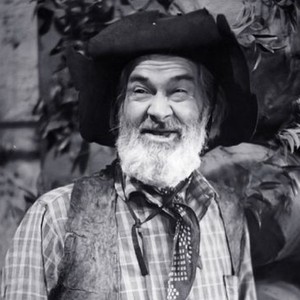Thomas Edwin Mix (born Thomas Hezikiah Mix;[1] January 6, 1880
![]()
Thomas Edwin Mix (born Thomas Hezikiah Mix;[1] January 6, 1880 – October 12, 1940) was an American film actor and the star of many early Western films between 1909 and 1935. He appeared in 291 films, all but nine of which were silent films. He was Hollywood’s first Western star and helped define the genre as it emerged in the early days of the cinema.[1]
Contents
- 1Early years
- 2Film career
- 3Radio
- 4Death
- 5Legacy
- 6Comic book appearances
- 7Cultural references
- 8Filmography
- 9References
- 10Further reading
- 11External links
Early years[edit]
Thomas Hezikiah Mix was born January 6, 1880, in Mix Run, Pennsylvania, approximately 62 miles (100 km) north of State College, to Edwin Elias Mix and Elizabeth Heistand. He grew up in nearby DuBois, where his father, a stable master for a wealthy lumber merchant, taught him to ride and love horses.[2] He spent time working on a local farm owned by John DuBois, a lumber businessman.
In April 1898, during the Spanish–American War, Mix enlisted in the Army under the name Thomas E. (Edwin) Mix. His unit never went overseas, and Mix later failed to return for duty after an extended furlough when he married Grace I. Allin on July 18, 1902. Mix was listed as AWOL on November 4, 1902, but was never court-martialed. His marriage to Allin was annulled after one year. In 1905, Mix married Kitty Jewel Perinne, and this marriage also ended within a year. He next married Olive Stokes on January 10, 1909, in Medora, North Dakota. On July 13, 1912, Olive gave birth to their daughter Ruth.
In 1905, Mix rode in President Theodore Roosevelt‘s inaugural parade with a group of 50 horsemen led by Seth Bullock, which included several former Rough Riders. Years later, Hollywood publicists muddled this event to imply that Mix had been a Rough Rider himself.
Mix went to Oklahoma and lived in Guthrie, working as a bartender and other odd jobs. He was briefly night marshal[3] of Dewey, in 1911. He worked at the Miller Brothers 101 Ranch, one of the largest ranching businesses in the United States, covering 101,000 acres (41,000 ha), hence its name. The ranch had its own touring Wild West show in which Mix appeared. He stood out as a skilled horseman and expert shot, winning national riding and roping contests at Prescott, Arizona, in 1909, and Canon City, Colorado, in 1910.[4]
Film career[edit]
Selig Polyscope[edit]
Mix in Mr. Logan, U.S.A., 1919
Mix began his film career as a supporting cast member with the Selig Polyscope Company. His first appearance was in a short film, The Cowboy Millionaire, released on October 21, 1909. In 1910, he appeared as himself in a short documentary film, Ranch Life in the Great Southwest, in which he displayed his skills as a cattle wrangler. Shot at the Selig studio in the Edendale district of Los Angeles (now known as Silver Lake), the film was a success, and Mix became an early motion picture star.
Mix performed in more than 100 films for Selig, many of which were filmed in Las Vegas, New Mexico. While with Selig he co-starred in several films with Victoria Forde, and they fell in love. He divorced Olive Stokes in 1917. By then, Selig Polyscope had encountered severe financial difficulties, and Mix and Forde both subsequently signed with Fox Film Corporation, which had leased the Edendale studio. They married in 1918 and had a daughter, Thomasina (Tommie) Mix, in February 1922.[3]
Mixville[edit]
Mix in 1925
Mix made more than 160 cowboy films throughout the 1920s. These featured action-oriented scripts contrasted with the documentary style of his work with Selig. Heroes and villains were sharply defined and a clean-cut cowboy always saved the day. Millions of American children grew up watching his films on Saturday afternoons. His horse, “Tony the Wonder Horse“, also became a celebrity. Mix did his own stunts and was frequently injured.
In 1913, Mix moved his family to a ranch he purchased in Prescott named Bar Circle A Ranch. Some of his movies were filmed in his Prescott home. During this time, Mix had success in the local Prescott Frontier Days rodeo, which claims to be the “world’s oldest rodeo”.[5] In 1920, he took first prize in a bull-riding contest. The Bar Circle A Ranch has been developed into a planned community called Yavapai Hills, where there is a street named Bar Circle A Road.
Mix’s salary at Fox reached $7,500 a week. Gossip columnist Louella Parsons wrote that he had his initials in electric lights on the top of his house.[6] His performances were realistic with action stunts, horseback riding, attention-grabbing cowboy costumes, and showmanship. At the Edendale lot, Mix built a 12-acre (4.9 ha) shooting set called Mixville. Loaded with western props and furnishings, it has been described as a “complete frontier town, with a dusty street, hitching rails, a saloon, jail, bank, doctor’s office, surveyor’s office, and the simple frame houses typical of the early Western era”.[7] Near the back of the lot an Indian village of lodges was ringed by miniature plaster mountains. The set also included a simulated desert, a large corral, and (to facilitate interior shots) a ranch house with no roof.
Mix threatened to move to Argentina to make films or to join the circus, but eventually he signed with FBO, which he then left for Universal after salary disputes with FBO studio head Joseph P. Kennedy. He called Kennedy a “tight-assed, money-crazed son-of-a-bitch”.[8]
Obverse of pocket watch given to Wyatt Earp by Tom Mix
Mix became friends with Wyatt Earp, who lived in Los Angeles and occasionally visited Hollywood western movie sets.[9] He was a pallbearer at Earp’s funeral in January 1929.[10] The newspapers reported that Mix cried during his friend’s service.[11]
1930s[edit]
Mix appeared with the Sells-Floto Circus in 1929, 1930, and 1931 at a reported weekly salary of $20,000 (equivalent to $316,000 in 2021). He and Forde divorced in 1931. Meanwhile, the Great Depression (along with the actor’s free-spending ways and many wives) reportedly had wiped out most of his savings. In 1932, he married his fifth wife, Mabel Hubbell Ward. Universal Pictures approached him that year with an offer to perform in “talkies,” which included script and cast approval. He acted in nine films for Universal, but because of injuries he received while filming, he was reluctant to do any more. Mix then appeared with the Sam B. Dill circus, which he reportedly bought two years later (1935).
Mix’s last screen appearance was a 15-episode sound Mascot Pictures serial, The Miracle Rider (1935); he received $40,000 for the four weeks of filming. Outdoor action sequences for the production were filmed primarily on the Iverson Movie Ranch in Chatsworth, California, on the outskirts of Los Angeles. The site was known for its huge sandstone boulders, and one of them later became known as Tom Mix Rock when it was discovered it had been used in The Miracle Rider. In one episode, Mix was filmed descending from the top of the rock, with boot holes carved into it to assist him in making the descent. The rock and the boot holes, although unmarked, is in the Garden of the Gods park in Chatsworth.[citation needed]
Also in 1935, Texas governor James V. Allred named Mix an honorary Texas Ranger. Mix returned to circus performing, now with his eldest daughter Ruth, who appeared in some of his films. In 1938, he went to Europe on a promotional trip, leaving Ruth behind to manage the circus. Without him, however, the circus soon failed, and he later excluded her from his will. Mix had reportedly made over $6 million (equivalent to $119 million in 2021) during his 26-year film career.[12]

































![Lieutenant-Colonel Robert Rogers (7 November 1731 – 18 May 1795) was a British Army officer and frontiersman. Born in Methuen, Massachusetts, he fought in King George’s War, the French and Indian War and the American Revolutionary War. During the French and Indian War, Rogers raised and commanded Rogers’ Rangers, a ranger unit trained for carrying out asymmetric warfare.[2][3](https://www.cowboyron.com/wp-content/uploads/2022/05/1262463_580743685323360_2133853937_o1-1-150x150.jpg)
















![Billie Joe Armstrong & Norah Jones – Silver Haired Daddy Of Mine [Music Video]](https://www.cowboyron.com/wp-content/uploads/2022/11/Al_St._John1-100x100.jpg)
























